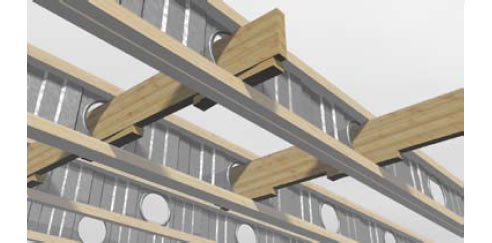Lightweight Composite Building Frame Beams from TECBUILD TECBEAM® - a light weight composite timber and steel 'I' beam with timber flanges and a continuous pressed steel web which transforms it's structural behavior into a beam with exceptional features; functioning more like a steel beam. TECBEAM CHARACTERISTICS: Stiffness - the continuous steel web enhances beam stiffness, reducing creep by over 60% compared with a seasoned timber beam, trussed joist or plywood 'I' beam, and over 80% for an unseasoned timber beam. No other timber engineered beams achieve this. Shear capacity - the engineered and patented Tecbeam steel web has a high shear capacity and reliable performance in comparison with solid timber, which can be relatively low in shear strength and prone to brittle failure. Strength - the continuous steel web enhances beam strength by up to 20%, floors can be designed for loads exceeding 15 kPa. (A quick solution for a short span bridge!) Ductility -at the ultimate load capacity, testing shows that web tensile yielding and shear buckling generally occurs before flange stresses reach the timber capacity. Web yielding occurs at the point of maximum bending moment, this action forms a local mechanism which is analogous to the ductile action in a steel beam. The Tecbeam joist undergoes an increased deflection but continues to carry significant load; this is an important safety feature in the structural integrity of a floor. In comparison, solid timber, open web truss type joists, and plywood 'I' beams, all undergo catastrophic collapse at their ultimate strength limit states. Creep Factor - long term load testing has established the creep or duration factor to be in the order of 1.3. In comparison, for solid seasoned timber the creep factor is 2.0, and for unseasoned timber it is 3.0. This lower creep factor means Tecbeam joists can often be used to replace steel beams, with significant savings. Point Loads - high concentrated loads can be placed anywhere along the flange because of the continuous steel web support. (Open web truss joists can have excessive local bending stresses where point loads occur between the nodes). Tecbeam joists are ideally suited to residential, commercial, industrial and car park structures where there are high point loads. Vibration - in long spans, all light weight joists exhibit vibration; in a Tecbeam floor this is easily controlled by using secondary beams installed at right angles to the joists, eg strongbacks, placed through the holes and securely fixed with wedges. The timber and steel web combination in Tecbeam joists provides better dampening characteristics than, floor trusses, plywood 'I' beams, steel purlin sections and lightweight all-steel joists. Load Sharing - where point or line loads occur, several Tecbeam joists in the immediate area can be connected by a short load spreading beam, or strongback, passing through the web holes. This provides a load sharing feature which often eliminates the need for a separate beam. Stability - the wide timber flanges provide excellent stability eliminating the need for blocking. Safety - Tecbeam joists provide greater safety due to their ductile behaviour, and no potential shear splitting as in a solid timber beam. They can remain serviceable after an overload, support high point and shear loads, and exhibit much lower creep compared with solid timber, plywood I beams and truss type joists. Use of secondary beams (strongbacks) provides additional safety margins through load sharing, as well as evening-out floor deflections and controlling floor vibration.
|
For enquires please contact Jack Haber at Tecbuild Systems on 0411 502 000
|
For enquires please contact Jack Haber at Tecbuild Systems on 0411 502 000
ENQUIRE HERE



 Sustainable LVL Construction with
Sustainable LVL Construction with Lightweight Structural Flooring Systems
Lightweight Structural Flooring Systems Timber Construction Projects with The
Timber Construction Projects with The Timber for Building Australia from The
Timber for Building Australia from The Timber for Major High-Rise Buildings
Timber for Major High-Rise Buildings Timber for Major Mid-Rise Buildings from
Timber for Major Mid-Rise Buildings from Timber-Based Public Housing Victoria
Timber-Based Public Housing Victoria Specifying for Mid-Rise Construction
Specifying for Mid-Rise Construction Cassette Long Span Prefabricated Panels
Cassette Long Span Prefabricated Panels Easy Services Coordination with Joists
Easy Services Coordination with Joists Lightweight Apartment Structure from
Lightweight Apartment Structure from Lightweight Large Span Joists from
Lightweight Large Span Joists from Tecbeam Joists Carry Setback Point Loads
Tecbeam Joists Carry Setback Point Loads Cantilevered Timber Balconies | Tecbeam
Cantilevered Timber Balconies | Tecbeam Cantilevered Timber Structure | Tecbeam
Cantilevered Timber Structure | Tecbeam Engineered Composite Floor Joist |
Engineered Composite Floor Joist | Floor Cassettes - Express Two Storey
Floor Cassettes - Express Two Storey Prefabricated Floor Cassette System |
Prefabricated Floor Cassette System | Timber Framed Construction for High
Timber Framed Construction for High Construction Costs Comparison | Tecbuild
Construction Costs Comparison | Tecbuild
